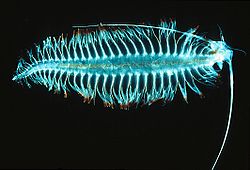Plankton
Plankton are drifting organisms that live in the surface layers of the ocean. They live in the top layer of the ocean, called the epipelagic zone. They are not strong enough to swim against ocean currents. The term is in contrast to nekton, who can control their movements.[1] There are three groups:
- Phytoplankton: which live at the surface of the ocean and photosynthesise (use light to make sugars and other molecules).
- Eukaryote algae: diatoms, coccolithophores, some dinoflagellates.
- Bacteria: cyanobacteria.
- Zooplankton: small protozoans or metazoans: Ctenophores; jellyfish; rotifers; foraminifera; tiny crustacea and other animals. Some eggs and larvae of larger animals such as fish, crustaceans, and annelids. Apart from the eggs, they all feed on other plankton.
- Some groups fall into both categories. Dinoflagellates can be either photosynthetic producers or heterotroph consumers; many species are mixotrophic depending upon their circumstances. It is also hard to fit viruses into this scheme; yet they are present in great numbers.
Plankton are important in the ocean's food chain. They are the main source of food for almost all fish larvae as they switch from their yolk sacs to catching prey. Basking sharks and blue whales feed on them directly; other large fish feed on them indirectly, by eating fish of smaller size, such as herrings.
The distribution of plankton is governed more by nutrients than by temperature. Large tracts of ocean are blue and sterile. The reason is that these areas lack one or more crucial nutrients for the photosynthetic plankton, upon whom all the others depend. Broadly speaking, areas near land masses get nutrients by rivers and wind. The key nutrient lacking in the Pacific ocean is iron, essential in molecules such as ferredoxins, iron-sulfur proteins which do electron transfer in a range of metabolic reactions.
Plankton Media
Marine microplankton and mesoplankton Part of the contents of one dip of a hand net. The image contains diverse planktonic organisms, ranging from photosynthetic cyanobacteria and diatoms to many different types of zooplankton, including both holoplankton (permanent residents of the plankton) and meroplankton (temporary residents of the plankton, e.g., fish eggs, crab larvae, worm larvae).Plankton species diversity Diverse assemblages consist of unicellular and multicellular organisms with different sizes, shapes, feeding strategies, ecological functions, life cycle characteristics, and environmental sensitivities.Courtesy of Christian Sardet/CNRS/Tara expeditions Salmon egg hatching into a sac fry. In a few days, the sac fry will absorb the yolk sac and start feeding on smaller plankton.
Tomopteris, a holoplanktic bioluminescence polychaete worm
Larva stage of a spiny lobster World concentrations of surface ocean chlorophyll as viewed by satellite during the northern spring, averaged from 1998 to 2004. Chlorophyll is a marker for the distribution and abundance of phytoplankton. Amphipod with curved exoskeleton and two long and two short antennae
References
- ↑ Thurman H.V. 1997. Introductory oceanography. Prentice Hall, N.J. ISBN 0-13-262072-3.





